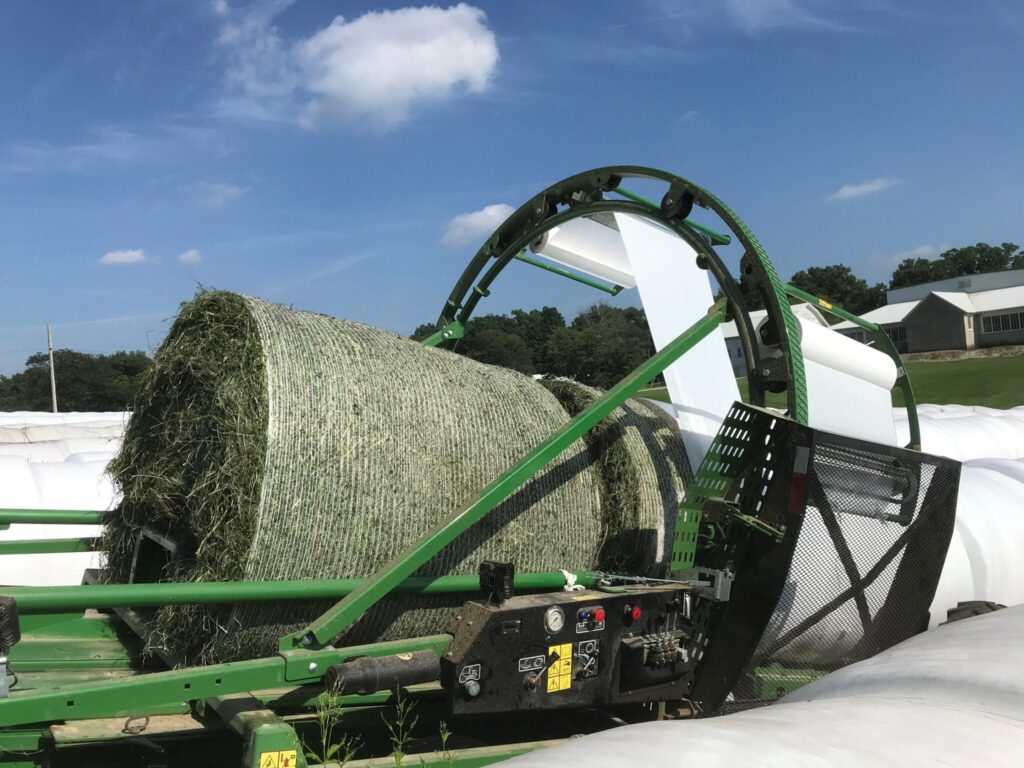Taking large round and large rectangular bales and wrapping them with white plastic to make bale silage (baleage) has become a common practice. A major reason for its adoption is to increase the chances of making quality forage when extended days without rain does not permit making dry hay.
Making baleage requires following a protocol so excellent fermentation occurs. There have been a couple cases of botulism recently in Indiana when small grain baleage was fed to cattle and horses. Proper fermentation is critical to reduce the chances of this tragic disease. The causative organism of botulism is the soil borne fungus Botulinum clostridium. The toxin cannot form if the silage pH is less than 4.5. A contributing factor to the concern is a high ash content from soil contamination with harvest procedures.
The following are guidelines to successfully make and use baleage.
- Crop quality – Good fermentation is dependent upon a supply of readily fermentable carbohydrates. Overly mature forage will have less nonstructural carbohydrate. Unlike the story of “Rumpelstiltskin” where straw was spun to gold, fermentation does not make poor quality forage a better feed resource.
- Moisture content – The best range of moisture content for proper fermentation is 50 to 60 percent. Uncut forage will be around 75 percent moisture. Generally the crop needs to wilt 6 to 24 hours to reach ideal moisture content to make baleage. Wilting time will be dependent upon crop type, yield, swath density and environmental conditions at harvest.
- Reduce soil contamination – During tedding and raking, set the equipment to reduce soil contamination in the swath and windrow.
- Bale density – A dense, tight bale improves fermentation as less pore space will be occupied by air. Proper fermentation requires an anaerobic environment.
- Bale shape – Bales should have similar outer dimensions so fewer air pockets result.
- Time between baling and wrapping – Bales should be wrapped as soon as possible after baling, ideally within 4 hours.
- Bale binding – Use plastic or untreated sisal twine, or plastic net wrapping to bind the individual bales at baling. Avoid treated sisal twine.
- Plastic – Tightly wrap each bale with six to eight layers of good-quality, 1-mil-thick plastic that is resistant to sunlight.
- Storage – Place the bales on a well-drained site. Inspect the bales often for the presence of holes in the plastic. Holes should be covered with ultraviolet light-protected plastic tape that can be purchased from the plastic provider. Do not use duct tape. Storing individually wrapped bales on end reduces holes caused by raptors, if a problem, since there is more overlap of wraps on the ends of the bale.
- Test for forage quality – After fermentation occurs, at least 4 weeks after wrapping, send a sample to a certified forage testing laboratory to determine the nutrient profile of the baleage. Make sure to request the forage quality variables moisture, crude protein, Neutral Detergent Fiber, Acid Detergent Fiber, and pH. Work with a trained nutritionist to develop rations to keep your livestock healthy and productive.
- Feeding – Utilize the bales within a year to reduce storage loss. Unwrap plastic on the baleage just prior to feeding to the livestock.
Making baleage is a way to harvest forage when extended number of dry days does not allow making dry hay. Following guidelines should improve fermentation and baleage quality.
Photo credit: Keith Johnson, Purdue Extension Forage Specialist

Wrapping hay to create baleage requires following a proper protocol for success.


